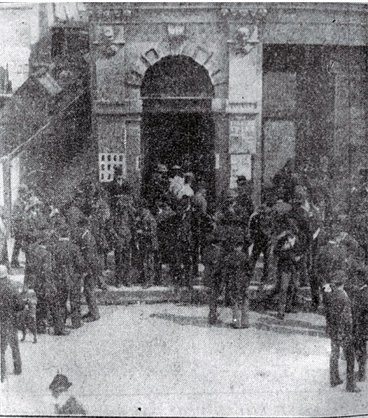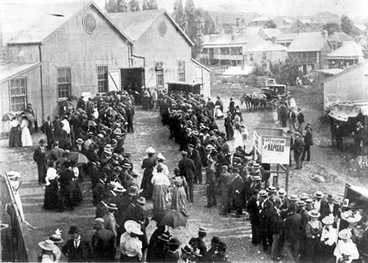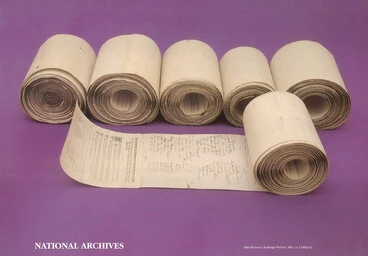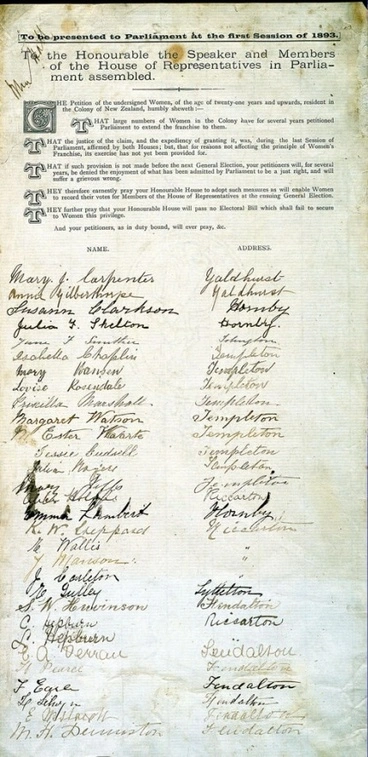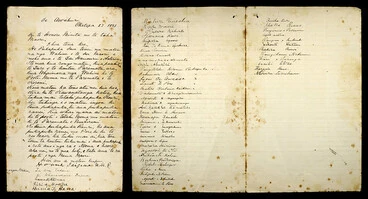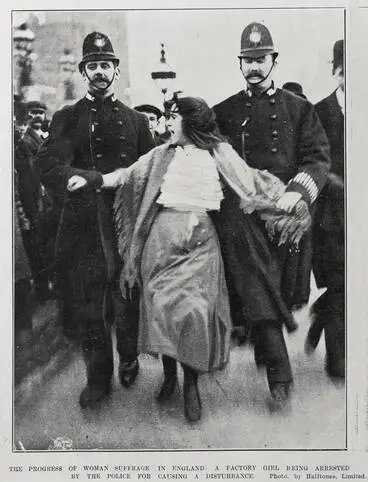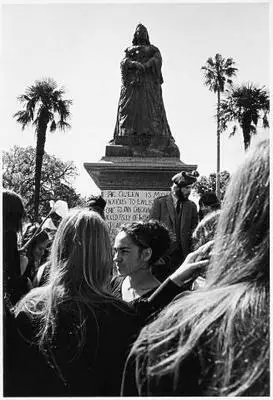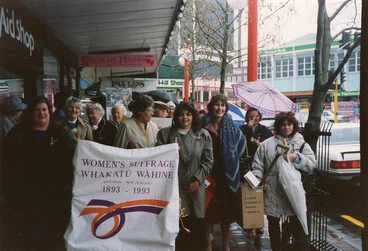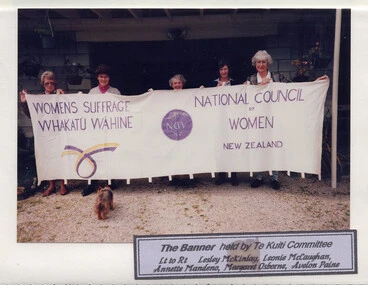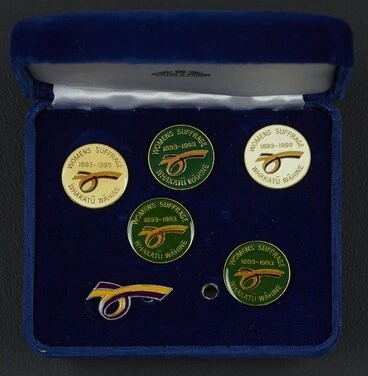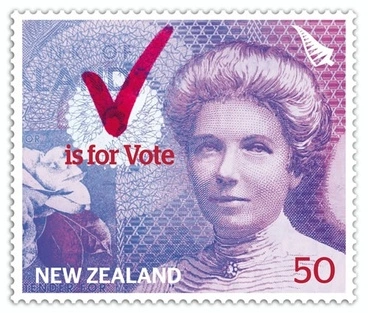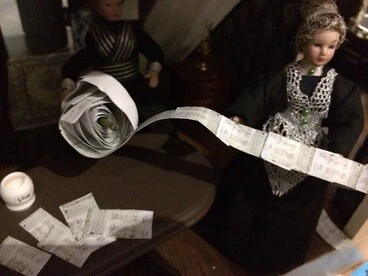Women first vote on 28 Nov 1893
A DigitalNZ Story by Zokoroa
NZ women voted first time on 28 Nov 1893; then supported British suffrage movement
Women, Suffrage, Sufftagette, Suffragist, Protests, Women's rights, Human rights, Activism, Elections, Kate Sheppard, Parliament
INTRODUCTION
Around 90,290 New Zealand women aged 21 or older went to the electoral polls for the first time on 28 November 1893. This number increased by 4000 three weeks later when voting for women who were registered in the four Māori electorates opened on 20 December 1893. Excluded from voting were non-British subjects which included Chinese migrants who had not applied for naturalisation under the Aliens Act 1880.
Since 1893, women aged 21 years and over were eligible to vote in the NZ general election
Image: Horse-drawn carriage & group of women & men at Tahakopa in South Island waiting to vote on 28 Nov 1893
Alexander Turnbull Library
90,290 women voted for the first time on 28 Nov 1893
Image: Women voters entering the Tuam Street Hall in Christchurch, 1893
Christchurch City Libraries
Four women at the polling booth at Provincial Buildings, Nelson, c.1893
Nelson Provincial Museum
Numbers of women voters increased in successive general elections
Image: Women queuing to vote in Auckland during 1899 NZ general election
Manatū Taonga, the Ministry for Culture and Heritage
New Zealand became the first self-governing country in which women had the right to vote in parliamentary elections. After receiving the electoral vote in 1893, NZ women gave their support to the British suffrage movement, including attending marches, and some were arrested during demonstrations. Eventually, the United Kingdom granted the vote to women in 1928. Images of mass marches are one of the enduring symbols of the suffrage movement.
NZ women carrying "New Zealand" banner in support of British suffrage procession to Hyde Park in London, 1910
Lady Anna Stout (standing left of centre, in front of the banner) was one of 150 speakers at Hyde Park
Auckland Libraries
NZ WOMEN GRANTED THE VOTE IN 1893
When NZ’s first parliamentary election was held in 1853, women were excluded from voting. In 1878, 1879, 1881 and 1882, bills were introduced to Parliament to enfranchise women but were unsuccessful. A number of women's groups began to be formed which also became involved with advocating for the right to women's franchise, including the New Zealand Women’s Christian Temperance Union (WCTU) (formed 1885), Tailoresses’ Union of New Zealand (1889), and the Women’s Franchise League (1892). Ngā Kōmiti Wāhine was also formed in 1893 by Meri Te Tai Mangakāhia for Māori women who sought the right to vote for, and stand for, Te Kotahitanga, the Māori Parliament.
Between 1887 – 1893, a series of petitions from women’s groups were presented to the House of Representatives. This led to suffrage bills being introduced in 1887, 1890, 1891 and 1892, but these were unsuccessful. In 1893, a series of 13 petitions requesting that the franchise be conferred on women signed by nearly 32,000 women were presented to the House of Representatives. Consequently, the Electoral Bill containing provision for women’s suffrage was introduced by Richard Seddon and passed by the Legislative Council on 8 September and consented to by the Governor, Lord Glasgow, on 19 September 1893.
Women first exercised their right to vote at the general election held on 28 November and 20 December 1893 in the European and Māori electorates, respectively.
Find out more:
- 'Women's suffrage milestones', URL: https://nzhistory.govt.nz/politics/womens-suffrage/suffrage-milestones, (Ministry for Culture and Heritage), updated 27-Apr-2023
- 'Meri Mangakāhia', URL: https://nzhistory.govt.nz/media/photo/so-that-women-can-get-the-vote, (Ministry for Culture and Heritage), updated 3-Oct-2023
When NZ’s first parliamentary election was held in 1853, women were excluded from voting
In 1878, 1879, 1881 and 1882, bills were introduced to Parliament to enfranchise women but were unsuccessful
Wikipedia
The suffrage campaign gained momentum in mid-1880s with women's groups forming, including WCTU, & submitting petitions
In 1891, this cartoon showed women were thought poised for victory in gaining the vote
Manatū Taonga, the Ministry for Culture and Heritage
Between 1887-1893, a series of petitions from women's groups called on the Government to grant the vote
This led to suffrage bills being introduced in 1887, 1890, 1891, 1892 and 1893, of which the last was successful
Archives New Zealand Te Rua Mahara o te Kāwanatanga
The successful 1893 petition was submitted to the NZ Parliament on 28 July by being unrolled down the central aisle
It comprised 13 petitions including a 'monster' petition with sheets pasted by Kate Sheppard (WCTU) into a roll
Auckland Libraries
The petition's sheets contained the names and addresses of about 31,872 women aged 21 years or older
The 'monster' petition contained 25,519 of the signatures
Manatū Taonga, the Ministry for Culture and Heritage
Subsequently, the Electoral Act was passed on 8 Sept & signed into law by the Governor, Lord Glasgow, on 19 Sep 1893
Eligible women to be "British subjects" which included Māori. Excluded were 'aliens' (Chinese could not vote until 1945)
The University of Auckland Library
On 27 Oct 1893, MP Hoani Taipua forwarded a letter to the Native Minister on behalf of 52 women at Ōtaki
The women's names had not appeared on the electoral roll & they asked to be included
Archives New Zealand Te Rua Mahara o te Kāwanatanga
109,461 women, or about 84% of those eligible, enrolled to vote in 1893 election
Archives New Zealand Te Rua Mahara o te Kāwanatanga
90,290 women voted for the first time on 28 Nov 1893
Manatū Taonga, the Ministry for Culture and Heritage
Up to 4,000 women voted three weeks later when voting in Māori electorates opened on 20 Dec 1893
Image: Lists the appointed polling booths for the 1893 parliamentary elections in the Māori electorates
Archives New Zealand Te Rua Mahara o te Kāwanatanga
NZ's experiences SUPPORTed SUFFRAGE MOVEMENT IN UK
BRITISH SUFFRAGE MOVEMENT:
The Women's Social and Political Union (WSPU) was formed by Emmeline Pankhurst in Manchester in 1905. The WSPU adopted the motto ‘Deeds not Words’, and organised their first large procession in February 1905. Forty suffragist societies and over 3000 women marched from Hyde Park to Exeter Hall in the rain and mud, which later became known as the 'Mud March'. Other demonstrations were subsequently held from 1906 to 1909, including at Hyde Park and Albert Hall. Some of demonstrators were arrested for causing a disturbance, including Emmeline Pankhurst and her daughter Christabel.
Newspaper account of the suffragettes' "riot" outside the Houses of Parliament, 1907
THE FEMALE SUFFRAGE CRUSADE. (Nelson Evening Mail, 10 April 1907)
National Library of New Zealand
Woman suffragist arrested 1907
THE PROGRESS OF WOMAN SUFFRAGE IN ENGLAND: A FACTORY GIRL BEING ARRESTED BY THE POLICE FOR CAUSING A DISTURBANCE
Auckland Libraries
Women marching towards the Albert Hall in London, 1908
REMARKABLE DEMONSTRATION BY SUFFRAGISTS: THE PROCESSION OF WOMEN MARCHING TO THE ALBERT HALL IN LONDON RECENTLY
Auckland Libraries
Christabel Pankhurst, co-founder of the Women's Social and Political Union (WSPU), speaking at Hyde Park, 1908
Christabel Pankhurst speaking in Hyde Park, London : Photograph
Wairarapa Archive
Release of Emmeline Pankhurst & daughter Christabel from Holloway Prison in London, 1909
The Release Of The Suffragette Leaders
Auckland Libraries
NZ WOMEN JOIN MARCHES in BRITAIN:
NZ women, including Lady Stout, joined in the two-mile long suffragist procession, 1910
Auckland Libraries
"The ladies [Lady Stout and included Dr. Alice Barn] carried a New Zealand banner and wands with trailing sprays of clematis twined with a ribbon of red, white and blue. An immense crowd gathered in Hyde Park and 150 speeches were delivered from 40 platforms, extending from the Marble Arch to the Serpentine." Auckland Weekly News 8 September 1910 p9
Lady Anna Stout was a foundation member of WCTU in 1885 & elected Dunedin's Women's Franchise League President in 1892
When the National Coucnil of Women was formed in 1896, she became Vice-President with Kate Sheppard as President
Alexander Turnbull Library
Lady Anna Stout (1858-1930) had become a foundation member of the Women's Christian Temperance Union (WCTU) in NZ in 1885. Seven years later in April 1892, she was elected president of the Women’s Franchise League in Dunedin. When the National Council of Women (NCW) was established in 1896, she became a vice-president with Kate Sheppard as president.
While in England between 1909 and 1912, Stout became involved in the Women’s Social and Political Union (WSPU). The WSPU used her status as a New Zealander and ‘possessor of the vote’ in their campaigns. She was involved in writing replies to The Times’ anti-suffrage correspondents, to help assure them that the women’s vote in New Zealand had not led to the collapse of society – that women were still good wives and mothers, that children continued to be born, and that the vote has not resulted in economic ruin. Her articles appeared in Votes for Women and the Englishwoman and were republished as leaflets and pamphlets by several suffrage associations.
Whilst in England from 1909-1912, Stout became involved in the Women's Social and Political Union (WSPU)
Image: Women's Suffrage meeting in Hyde Park, 1910 London.
Auckland Libraries
The WSPU used Stout's status as a New Zealander & ‘possessor of the vote’ in their campaigns, including media articles
Image: Napkin created for a ‘Votes for Women’ procession held in London on 23 July 1910
Museum of New Zealand Te Papa Tongarewa
'Votes for Women' sash worn in British women’s suffrage campaign parade circa 1908-1911
Auckland War Memorial Museum Tāmaki Paenga Hira
Kiwi arrested during suffragist campaigns:
In 1896, Frances Mary Parker (1875-1924) left New Zealand to attend Cambridge University. She joined the Women’s Social and Political Union (WSPU) in 1908, and was involved in the suffragists campaigns in London, where she was imprisoned for six weeks for obstruction following a demonstration.
In 1911, Prime Minister Asquith had announced a manhood suffrage bill, which was seen as a betrayal of the women’s suffrage campaign. In protest, the WSPU organised a mass window-smashing campaign through London over the following months. Parker was amongst those arrested in March 1912 during one of the window-smashing processions and spent four months in the Holloway Prison. She was rearrested twice later that year and was released a couple of days later after going on a hunger strike.
Frances Parker (NZ) was imprisoned with over 200 suffragettes in March 1912 for window-smashing during London procession
Votes for women - suffragettes' window-smashing raid in London
Auckland Libraries
London procession, 1912
The march of 40,000 women - Māori girl becomes an emblem in support of women's suffrage
Auckland Libraries
London procession, 1912
Suffragettes invade London - strange arguments in favour of votes for women
Auckland Libraries
Suffragette outside Bow-Street Police Station after the window-smashing raid
Hardly So Cheerful-Looking As She Declares
Auckland Libraries
Suffragette arrested for throwing bag of flour at Prime Minister Asquith during meeting at Chester, 1912
In The Arms Of The Law
Auckland Libraries
Article about Lady Anna Stout & other New Zealanders' support for women suffragettes in Britain, 1912
NEW ZEALANDERS ABROAD. (NZ Truth, 22 June 1912)
National Library of New Zealand
Sylvia Pankhurst about to lead a procession to House of Commons, 10 June 1914
Auckland Libraries
Irish women took part in procession through Piccadilly, 1914
'Suffragette week' in London
Auckland Libraries
Suffragettes arrested outside Buckingham Palace, 1914
Suffragette raid which proved a fiasco, with men and women arrested outside Buckingham Palace, London, 21 May 1914 while riotously attempting to pe...
Auckland Libraries
Suffragette arrested during riot outside Buckingham Palace, 1914
Policemen escorting a militant suffragette and follower of Mrs Pankhurst to gaol
Auckland Libraries
Kiwi received WSPU medal for valour, 1914:
After campaigning in London, Frances Parker became a leader of the WSPU Scotland and was involved in protests to burn down prominent buildings. She was arrested in July 1914 for attempting to blow up the cottage of Robbie Burns, Scotland's national poet. Her prison experience where she went on a hunger strike and was force-fed is recounted in an article where she used the pseudonym Fanny Parker. See: Scottish Archives for schools: The case of Fanny Parker alias Janet Arthur. Parker was given a Hunger Strike Medal "for Valour" by the WSPU, which is held in Te Papa's collections.
WSPU medal "for Valour" awarded to Frances Parker, 1914
Museum of New Zealand Te Papa Tongarewa
Marching in remembrance of NZ Suffrage Day
In remembrance of the marches and demonstrations of the suffragettes' campaign, commemorations have been held over the decades in New Zealand. As well as celebrating the achievement of the women's electoral vote, the marches and gatherings are also a reminder of the ongoing importance to keep furthering fundamental human rights.
In 1975, voters no longer had to be a "British subject"; permanent residents could vote, whether or not they had New Zealand citizenship. Currently, citizens and those with a resident visa who have been living in NZ continuously for one year are eligible to vote in a Parliamentary or Local Election. The voting age was lowered from 21 to 20 in 1969 and to 18 in 1974.
North Shore, 1993
North Shore Women's Suffrage Centennial march, 1993
Archives New Zealand Te Rua Mahara o te Kāwanatanga
Christchurch, 1993
Suffrage Day 1993, Bridle Path Walk, Christchurch
Archives New Zealand Te Rua Mahara o te Kāwanatanga
Christchurch, 1993
Christchurch Square, Suffrage Day, 1993
Archives New Zealand Te Rua Mahara o te Kāwanatanga
Mount Climie, Upper Hutt, Wellington, 1993
Women's Suffrage Centennial, 1993; Mount Climie
Upper Hutt City Library
Te Kuiti Committee, National Council of Women, 1993
Te Kuiti Committee, National Council of Women, 1993
Archives New Zealand Te Rua Mahara o te Kāwanatanga
Images of NZ women exercising their right to vote
Election day in Wellington, 1902
Election day in Wellington with the crowd gathered in front of the skating rink polling booth, Mr Seddon( left foreground)
Auckland Libraries
Woman about to cast her electoral vote for the first time, ca 4 Dec 1935
Woman about to cast her electoral vote for the first time
Alexander Turnbull Library
Image: Mother inside voting, 1935. (That year, 89.46% of women on the European electoral roll voted)
crowd-ffromttkej balcony, offthe "Evening .Posf'-abpiU, midnight. Mindmg:,baby?wh'ile [mother votes, a scene outside one of.the polling " —■■'■■ \ ...
National Library of New Zealand
Outside polling booth, 1959
Children and adults standing outside a polling booth at an unidentified church, probably in the Wellington region
Alexander Turnbull Library
Wellington, 1972
General Election polling booth at the Children's Dental Clinic, Willis Street, Wellington
Alexander Turnbull Library
In 1969, the voting age was lowered from at least 21 years to 20 years
One of the 20- year-olds able to vote for the first time in 1969
Tauranga City Libraries
In 1974, the voting age was lowered from at least 20 years to 18 years
Entering a polling booth during 1996
Manatū Taonga, the Ministry for Culture and Heritage
Commemorations
Kate Sheppard's portrait has appeared on the NZ ten dollar note since 1992
On the left are white camellia flowers which were given to members of Parliament who supported the suffrage bill
Manatū Taonga, the Ministry for Culture and Heritage
The Kate Sheppard National Memorial was unveiled on 19 Sept 1993, to commemorate 100 years since women won right to vote
L-R: Meri Te Tai Mangakāhia, Amey Daldy, Kate Sheppard, Ada Wells, Harriet Morison & Helen Nicol
Christchurch City Libraries
The plaque & bronze panels record a written history of Kate Sheppard & the suffrage movement
The memorial stands by the Avon River on Oxford Terrace, Christchurch & was sculpted by Margriet Windhausen
Christchurch City Libraries
Kate Sheppard's bust was presented by the Women’s Christian Temperance Union to the NZ Parliament in 1993
Manatū Taonga, the Ministry for Culture and Heritage
These commemorative enamelled pins were produced as part of events celebrating 100 years of Women’s Suffrage in 1993
Archives New Zealand Te Rua Mahara o te Kāwanatanga
The dedication of a Camellia Hedge between the Hilgendorf and Burns Building at Lincoln University, 1993
Lincoln University
Planting a 'Kate Sheppard' camellia in a public garden in Hastings, 1993
Manatū Taonga, the Ministry for Culture and Heritage
Kate Sheppard features in The A to Z of New Zealand stamp series produced by NZ Post in 2008
Manatū Taonga, the Ministry for Culture and Heritage
Suffrage-themed dolls house on display at The Piano. WORD Christchurch Festival 2018
Christchurch City Libraries
Suffrage display at Christchurch City Libraries (Tūranga), Sept 2023
Christchurch City Libraries
Suffrage display at Christchurch City Libraries (Tūranga), Sept 2023
Christchurch City Libraries
Suffrage Day display at Christchurch City Libraries (Lyttelton), Sept 2023
Christchurch City Libraries
Petition displayed in He Tohu exhibition in National Library of New Zealand Te Puna Mātauranga o Aotearoa, Wellington
Manatū Taonga, the Ministry for Culture and Heritage
You can search digitised 1893 women's suffrage petition: https://nzhistory.govt.nz/politics/womens-suffrage/petition
In 2011, largest of the 13 petitions (270 metres), & the only one which survives, was digitised by Archives New Zealand
Manatū Taonga, the Ministry for Culture and Heritage
Sources:
- Archives New Zealand: Citizenship: https://archives.govt.nz/citizenship
- David Pearson, 'Ethnic inequalities - European majority, Asian minorities: 1840–1945', Te Ara - the Encyclopedia of New Zealand, http://www.TeAra.govt.nz/en/ethnic-inequalities/page-3
- Neill Atkinson, 'Voting rights - 20th-century reforms', Te Ara - the Encyclopedia of New Zealand, http://www.TeAra.govt.nz/en/voting-rights/page-5
- Scottish Archives for Schools: The case of Fanny Parker alias Janet Arthur: https://www.scottisharchivesforschools.org/suffragettes/fannyParkerOrJanetArthur.asp
- Te Papa: Who was Lady Anna Stout: https://www.tepapa.govt.nz/discover-collections/read-watch-play/history/new-zealanders-and-british-suffrage-movement/lady-anna-stout
- Wikipedia: 'Women's suffrage in the United Kingdom': https://en.wikipedia.org/wiki/Women%27s_suffrage_in_the_United_Kingdom
- 'Women's suffrage milestones', URL: https://nzhistory.govt.nz/politics/womens-suffrage/suffrage-milestones, (Ministry for Culture and Heritage), updated 27-Apr-2023
- 'Women's suffrage petition', URL: https://nzhistory.govt.nz/politics/womens-suffrage/petition, (Ministry for Culture and Heritage), updated 13-Mar-2018
